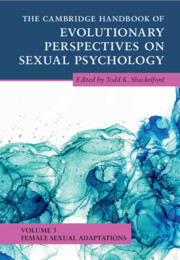Book contents
- The Cambridge Handbook of Evolutionary Perspectives on Sexual Psychology
- The Cambridge Handbook of Evolutionary Perspectives on Sexual Psychology
- Copyright page
- Contents
- Contributors
- Preface
- Part I Precopulatory Adaptations
- 1 Women’s Preferences: Precopulatory Adaptations
- 2 Female Sexual Attraction Tactics
- 3 Extra-Pair Sexual Interest
- 4 Female Intrasexual Competition
- 5 Female Intersexual Selection
- 6 Evolution of Precopulatory Defense from Rape and Coercion in Women
- 7 Mate Poaching
- Part II Copulatory Adaptations
- Part III Postcopulatory Adaptations
- Index
- References
6 - Evolution of Precopulatory Defense from Rape and Coercion in Women
from Part I - Precopulatory Adaptations
Published online by Cambridge University Press: 30 June 2022
- The Cambridge Handbook of Evolutionary Perspectives on Sexual Psychology
- The Cambridge Handbook of Evolutionary Perspectives on Sexual Psychology
- Copyright page
- Contents
- Contributors
- Preface
- Part I Precopulatory Adaptations
- 1 Women’s Preferences: Precopulatory Adaptations
- 2 Female Sexual Attraction Tactics
- 3 Extra-Pair Sexual Interest
- 4 Female Intrasexual Competition
- 5 Female Intersexual Selection
- 6 Evolution of Precopulatory Defense from Rape and Coercion in Women
- 7 Mate Poaching
- Part II Copulatory Adaptations
- Part III Postcopulatory Adaptations
- Index
- References
Summary
Rape and sexual coercion have been recurrent adaptive challenges for women over human evolutionary history. There are many reproductive, physical, and psychological costs of sexual victimization, including mitigation of female sexual choice. The use of rape and coercion are well-documented behaviors in human males intended to circumvent female rejection. The intersexual conflict resulting from these deceptive and sometimes violent tactics likely generated selection pressures for a female defense system to protect reproductive choice. This chapter synthesizes a broad domain of research on the psychology of rape perpetration and avoidance to suggest that women may have evolved a specialized threat management system to mitigate their risk of rape and coercion. This system is hypothesized to be sensitive to inputs that signal either an increased likelihood of sexual victimization or greater costs of sexual victimization. Such inputs are expected to produce an emotional response, fear, that motivates avoidant behavior to preemptively avoid sexual victimization. Here, we discuss research in support of a precautionary psychological threat management system for rape avoidance, highlighting potential inputs to and outputs from this system.
- Type
- Chapter
- Information
- Publisher: Cambridge University PressPrint publication year: 2022



